Octopuses are insanely talented: They’ve been observed building forts, playing games, and even walking on dry land. But one area where the cephalopods come up short is in the social department. At least that’s what marine biologists used to believe. Now a newly discovered underwater community, dubbed Octlantis, is prompting scientists to call their characterization of octopuses as loners into question.
As Quartz reports, the so-called octopus city is located in Jervis Bay off Australia’s east coast. The patch of seafloor is populated by as many as 15 gloomy octopuses, a.k.a. common Sydney octopuses (octopus tetricus). Previous observations of the creatures led scientists to think they were strictly solitary, not counting their yearly mating rituals. But in Octlantis, octopuses communicate by changing colors, evict each other from dens, and live side by side. In addition to interacting with their neighbors, the gloomy octopuses have helped build the infrastructure of the city itself. On top of the rock formation they call home, they’ve stored mounds of clam and scallop shells and shaped them into shelters.
There is one other known gloomy octopus community similar to this one, and it may help scientists understand how and why they form. The original site, called Octopolis, was discovered in the same bay in 2009. Unlike Octlantis, Octopolis was centered around a manmade object that had sunk to the seabed and provided dens for up to 16 octopuses at a time. The researchers studying it had assumed it was a freak occurrence. But this new city, built around a natural habitat, shows that gloomy octopuses in the area may be evolving to be more social.
If that's the case, it's unclear why such octo-cities are so uncommon. "Relative to the more typical solitary life, the costs and benefits of living in aggregations and investing in interactions remain to be documented," the researchers who discovered the group wrote in a paper published in Marine and Freshwater Behavior and Physiology [PDF].
It’s also possible that for the first time in history humans have the resources to see octopus villages that perhaps have always been bustling beneath the sea surface.
[h/t Quartz]
